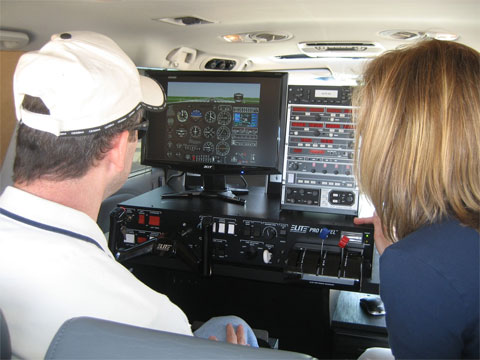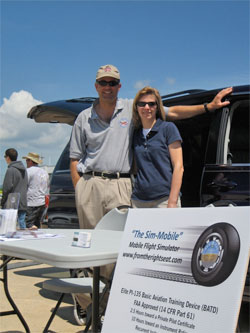
What would you rather do on your lunch hour—run errands and cram a sandwich, or get in some solid instrument work? If you live in the Baltimore-Washington, D.C., area, your options have expanded. A local CFII will bring a complete simulator setup to you.
The Sim-Mobile features an ELITE PI-135 Basic Aviation Training Device (BATD) with yoke, rudders, and two monitors. The hardware is transported in a minivan—hence the “Mobile” part of the name. The pilot sits in the rear seat of the van; the hardware takes up the space that normally would be occupied by the center passenger seats, but it can easily be removed and set up in a home or office.
CFII Meredith Tcherniavsky of Rockville, Md., got the idea of a mobile simulator from pet groomers and other come-to-you types of operations.
The lagging economy and the price of aviation fuel have affected Tcherniavsky’s flight instruction business, she said. People are afraid not to go to their jobs, and many who are learning to fly are scheduling lessons for evening and weekend hours. Private pilots are flying the bare minimum to stay current, she said. “My husband and I are driving to Oshkosh this year” for EAA AirVenture, she said. “We can’t afford to fly ourselves.”
 Dana (left) and Meredith Tcherniavsky and the Sim-Mobile during International Learn to Fly Day on June 4 at Frederick Municipal Airport.
Dana (left) and Meredith Tcherniavsky and the Sim-Mobile during International Learn to Fly Day on June 4 at Frederick Municipal Airport.
Simulator dual training can be cheaper and more convenient than renting an airplane, enabling pilots to keep their heads in the game and remain safer, Tcherniavsky said.
The federal aviation regulations permit student pilots to log up to 2.5 hours in an approved simulator toward a private pilot certificate, and instrument students can log up to 10 hours in a BATD. Popular PC-based simulator programs are useful for practicing instrument approaches, but that time can’t be counted toward a certificate or rating. See AOPA’s aviation subject report for more information.
Even if students exceed the number of hours that can be logged in a simulator, the additional time spent learning procedures increases their confidence and reduces training time and costs overall, Tcherniavsky said.
The sim also can be used for those instances when you just don’t want to climb into a cockpit. A client who did not want to fly his airplane on a recent 100-degree day was able to fly the simulator, which Tcherniavsky programmed with the type of turbulent, bumpy winds aloft they would have encountered.
You can view the Sim-Mobile on June 28 at Davis Airport in Laytonsville, Md., when Tcherniavsky will host a free seminar from 7 to 10 p.m. Or, see the From the Right Seat website for more information.


